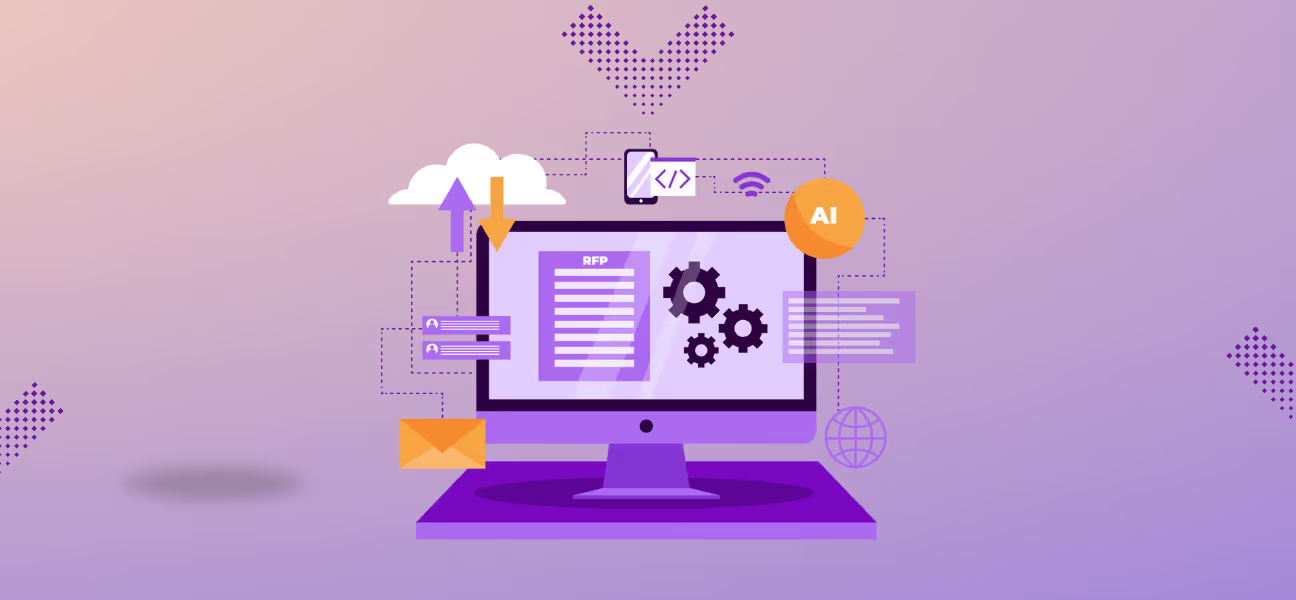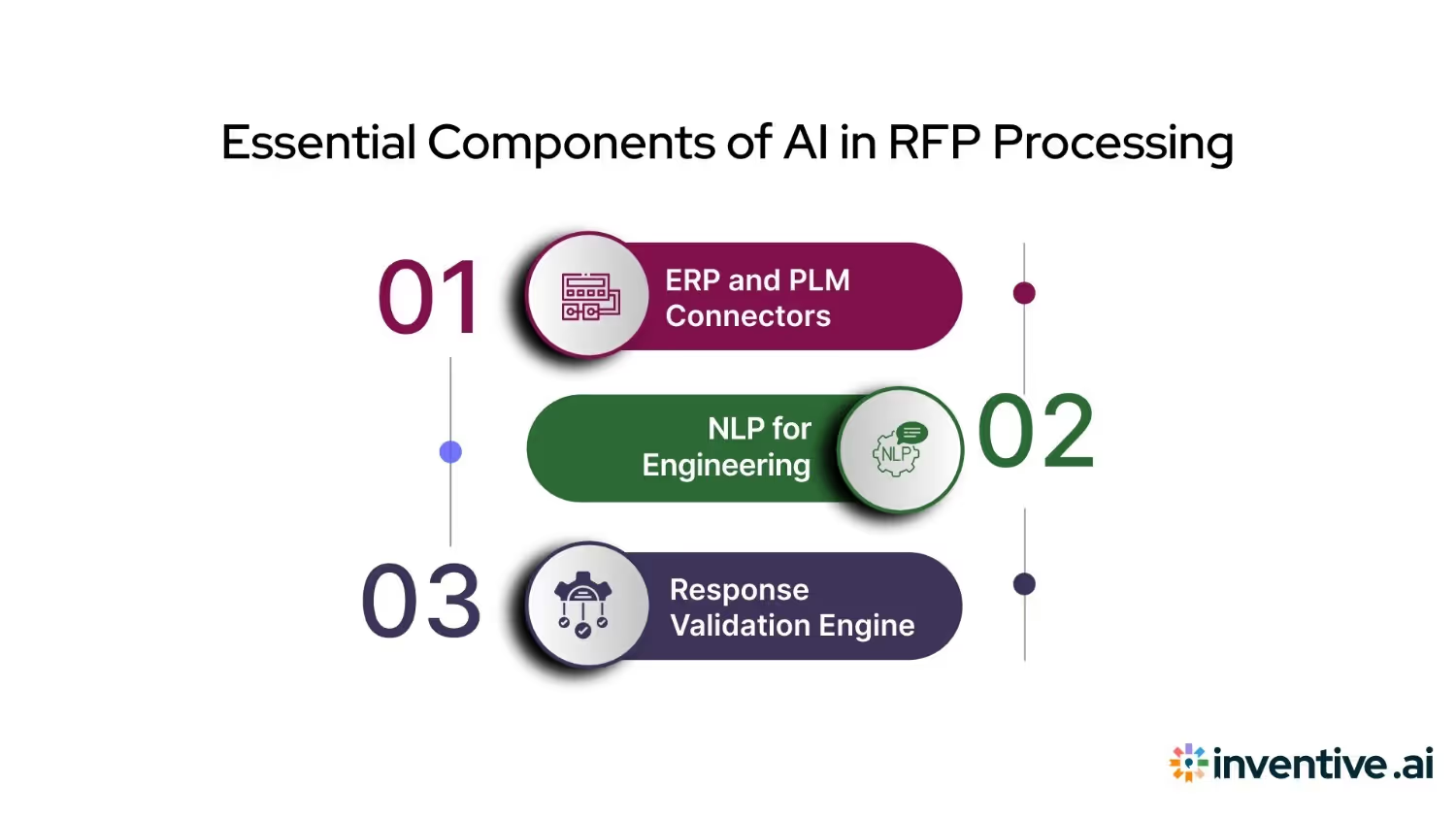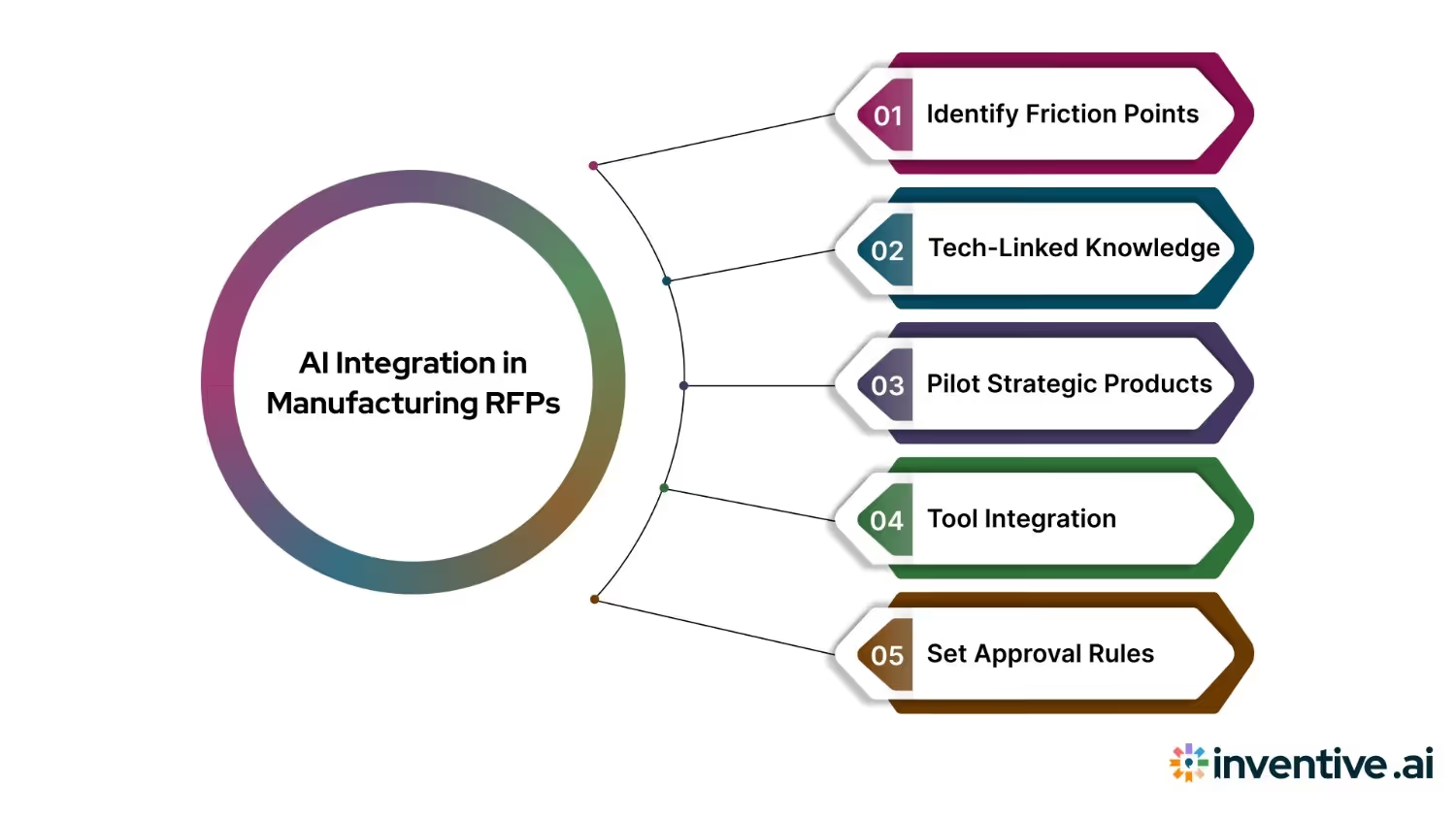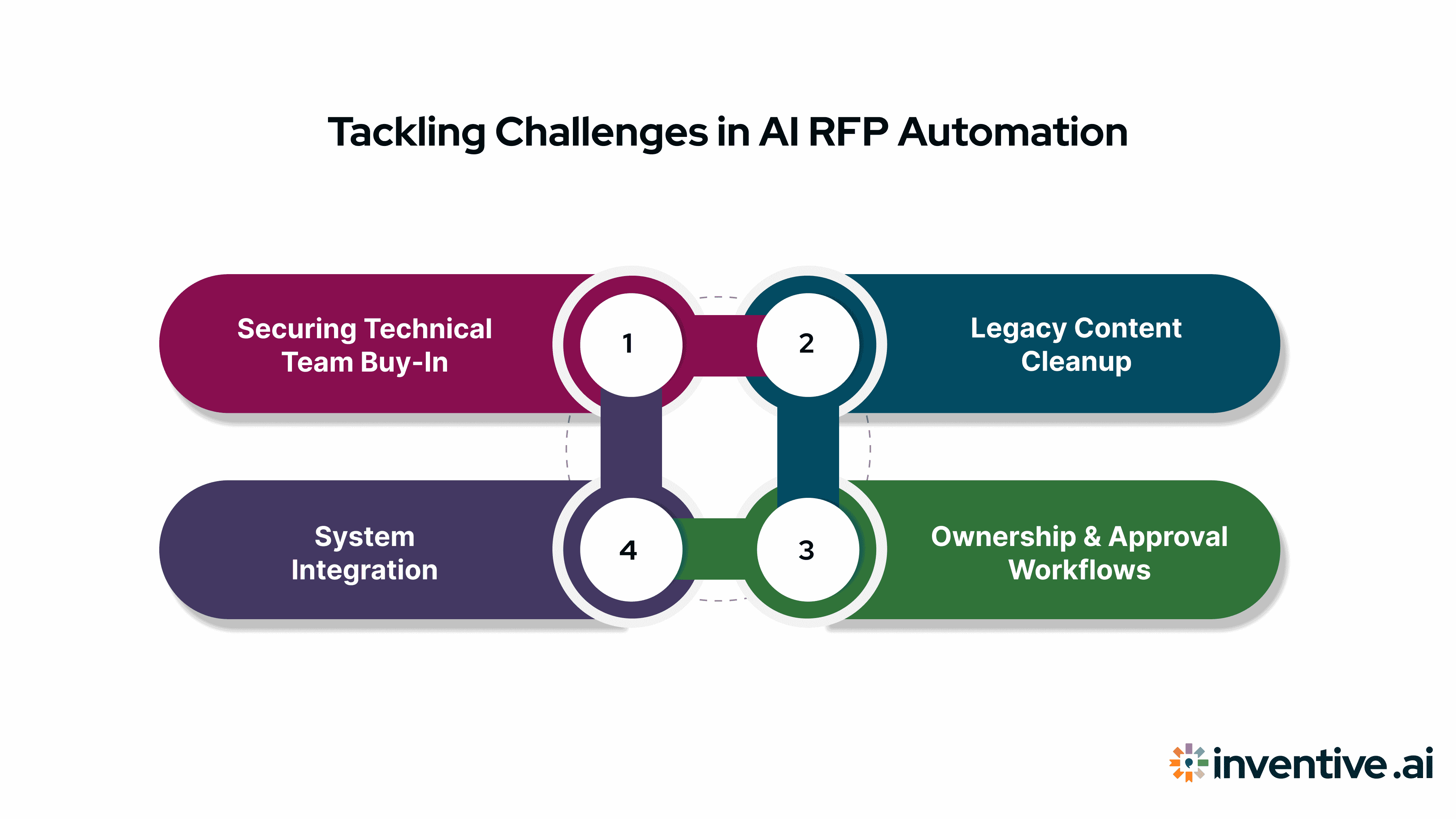Integrating AI for RFP Automation in Manufacturing
Transform RFP processes with AI integration! Discover benefits and steps to automate in manufacturing. Click to boost efficiency and decision-making!

Manufacturing RFPs are rarely simple. Responding means pulling together specifications, CAD drawings, part lists, supplier data, and certifications like ISO or RoHS. That work is often spread across systems and teams, making it slow, repetitive, and prone to gaps.
AI helps streamline this process. It can pull the right files, suggest accurate responses based on past bids, and reduce the manual back-and-forth between sales and engineering. For leaders, the benefits are evident in faster turnaround times, fewer errors, and more bids submitted without overloading the team.
Adoption is already underway: 56% of organizations are now utilizing AI to enhance business operations. In this blog, we’ll walk through how to apply that momentum to your RFP workflow, what to automate first, how to structure your rollout, and what outcomes to measure.
TL;DR: What You’ll Learn
- Why manufacturing RFPs are complex — with specs, drawings, and certifications that slow down manual responses.
- How AI automates requirement extraction, content reuse, and compliance formatting with high accuracy.
- A step-by-step plan to integrate AI into your current RFP workflow without disruption.
- How Inventive AI enables faster, error-free responses with contextual drafting, smart collaboration, and source-linked answers.
What Is an RFP?
A Request for Proposal (RFP) is a formal document issued by organizations seeking bids for a specific project or service. It outlines project requirements, evaluation criteria, timelines, and submission guidelines. In manufacturing, RFPs often include detailed technical specifications, compliance expectations, and delivery standards, making the response process complex and high-stakes. Responding effectively requires accuracy, clarity, and alignment with both the buyer’s needs and industry regulations.
Overview of the Current RFP Process in Manufacturing
Manufacturing RFP's are inherently complex. Whether the buyer is sourcing raw materials, production equipment, or contract services, they prioritize precision, compliance, and proven capability.
Each submission must demonstrate the supplier’s ability to meet strict specifications, including material grades, tolerances, delivery schedules, and quality certifications, all backed by formal documentation.
These RFPs typically include multi-tab pricing sheets, CAD drawings, compliance forms, and highly specific submission instructions tailored to the buyer’s industry and regulatory needs.
This depth is expected in sectors like automotive, aerospace, and medical devices, where supplier selection hinges on traceability and operational reliability. To meet these expectations, most manufacturers follow a traditional, document-heavy model, drawing on legacy files, SME inputs, and established internal workflows.
Limitations of Traditional RFP Response Processes
The traditional approach to RFPs in manufacturing relies heavily on manual coordination, siloed systems, and static content reuse. While it’s familiar, this model creates friction at nearly every step, especially as RFP volume and complexity grow.
Key Limitations Response Teams Face:
1. Spec-to-Response Mismatch: Manual reviews often lead to misinterpretation of technical specs, such as incorrect tolerance ranges, finish types, or packaging requirements, resulting in non-compliant bids or costly clarifications.
2. Disconnected Systems and Teams: Engineering teams may work in PLM tools, costing teams in ERP, and proposal teams in Word or Excel. Without system integration, response teams spend hours copying data, reconciling formats, and chasing updates across departments.
3. Lack of Version Control and Reuse: There’s no unified knowledge base. Responses are built from scratch or patched together from old emails and folders. SMEs are repeatedly asked the same questions, and answers often vary depending on who responds and when.
4. Legacy Systems Can't Keep Up: Most manufacturing tech stacks were built for production and planning, not rapid, cross-functional collaboration on complex RFPs. Legacy tools lack the flexibility to handle dynamic document types, real-time data pulls, or role-based content workflows.
This fragmentation not only slows down response time, but it also introduces inconsistencies that can compromise the quality and credibility of every submission.
Tired of long review cycles, version cycles, and copy-paste fatigue? Inventive AI turns your fragmented RFP workflow into a streamlined, AI-driven system. Teams using Inventive AI have reported up to 90% faster RFP completion times, without sacrificing accuracy. Explore how Inventive AI works
You already know the manual process isn’t scaling up. But what can you actually do to streamline it? You can’t replace every legacy system or workflow overnight. This is where automation can start to reshape how your team responds—and how your business operates.
Why Automation Is Now Critical for Manufacturing RFPs
Manual RFP processes that once worked are now becoming a liability. As procurement expectations shift and bid volume increases, response teams need tools that move as fast and accurately as the opportunities they’re chasing.
Compressed Turnaround Windows
In many industries, especially automotive, aerospace, and electronics, buyers now issue RFPs with 3–5 day deadlines. There's no buffer for delays caused by cross-team coordination or rework. Automation enables faster extraction, matching, and population of responses, without compromising accuracy.
More Complex Buyer Requirements
Manufacturing RFPs no longer just ask for pricing and specs. Teams are expected to complete ESG disclosures, cybersecurity certifications, digital compliance forms, and supplier traceability details. These added layers require a level of response structure and content control that manual tools can’t sustain.
Higher Volume, Lower Margin
With global competition and tighter profit margins, manufacturers are bidding on more RFPs just to stay competitive. That increased volume means traditional methods don’t scale. Automating routine response tasks frees up SMEs and ensures proposal teams can handle more bids without sacrificing quality.
So if automation is the path forward, the next step is understanding how AI actually supports your RFP process. Not every tool can handle technical specs, versioned content, or compliance-heavy documents, but AI can be set up to do exactly that.
Understanding AI-Driven RFP Automation
In a survey, 78% of respondents said their organizations use AI in at least one business function. AI automation is becoming standard across industries, and the procurement space is no exception.
But when it comes to manufacturing RFPs, AI has to do more than just assist; it needs to read technical drawings, interpret critical language, and work with the systems you already use. The value comes from how well it understands the complexity you're dealing with.
In this section, we’ll break down what that looks like in practice, what AI-powered automation actually does, what it’s built on, and how it helps manufacturing teams respond with greater speed and accuracy.
Behind the capabilities of AI are specific systems and integrations that allow AI to operate with accuracy and control.
Key Components of AI Systems Used in RFP Processing

The effectiveness of AI in RFP automation depends on how well it’s connected to your internal systems and how accurately it handles technical inputs. These are the components that make that possible:
1. ERP and PLM Connectors: AI tools built for manufacturing link directly to systems like SAP, Oracle, or Windchill. This allows the AI to pull accurate data on materials, part availability, pricing, and lead times, without waiting for manual lookups or email chains.
2. Natural Language Parsing for Engineering Language: Unlike general-purpose AI, RFP-specific models are trained to understand technical phrasing. They can interpret buyer language and map it to your terminology or processes.
3. Response Validation Engine: This layer checks each auto-filled answer against versioned source content. For example, if the AI suggests a quality certification or test method, the validation engine confirms whether it’s current and approved for external use.
With these systems in place, AI can carry out the essential functions that slow down traditional RFP workflows.
Core Functionalities of AI in RFP Automation
AI automation in manufacturing RFPs needs to do more than generate answers. It must understand the technical context, interpret layered requirements, and respond with accuracy at scale.
Here’s what that looks like in practice:
1. Requirement Matching: AI can scan line items, CAD notes, and spec sheets to identify what’s being requested and match those requirements to your internal capabilities. It recognizes tolerances, materials, part families, certifications, and flags anything that falls outside your delivery scope.
2. Contextual Answer Generation: Instead of pulling canned responses, AI references past submissions, technical documents, and internal notes to write answers that reflect the nuances of each bid. It understands the difference between responding to a question on "surface treatment" versus "coating durability" and adapts accordingly.
3. Document and Input Classification: AI can automatically classify incoming documents like pricing forms, checklists, CAD attachments, and route them to the right teams. It reduces time lost sorting through attachments or identifying what needs SME input.
These functions of AI not just streamline the process, but they also lead to clear, measurable gains across your team’s workload.
Benefits of AI RFP Automation for Manufacturing
AI automation delivers clear, measurable advantages for manufacturing response teams. AI-driven automation can tackle the limitations of your legacy procurement process without replacing the whole system.
1. Reduced Dependency on SMEs
AI handles repetitive inputs like standard compliance language, material specs, and process explanations, so engineers and technical staff aren’t constantly pulled away from their core responsibilities.
2. Improved First-Pass Accuracy
With AI drawing from validated sources like verified internal documents and up-to-date libraries, responses are more likely to be right the first time. This reduces back-and-forth between teams and helps avoid last-minute corrections that delay submission.
3. Faster Internal Turnaround
Task routing, deadline tracking, and automated drafting help teams move faster without sacrificing quality. Multiple reviewers can work in parallel instead of waiting for handoffs.
4. Higher Overall Speed and Volume
AI can generate up to 80% of a first draft in minutes, allowing teams to respond to more RFPs in less time. What used to take days now takes hours, making it possible to chase more opportunities without overloading staff.
5. Stronger Compliance and Formatting Control
Instead of relying on manual checks, AI applies the correct templates, compliance clauses, and formatting rules automatically, reducing errors that could get a bid rejected on a technicality.
6. Centralized Collaboration and Version Control
With everyone working from the same platform, proposal inputs aren’t lost across shared drives or outdated files. Contributors can track updates in real time, reduce duplication, and keep progress visible.
7. Scalability Without Extra Headcount
By offloading routine drafting and formatting work, AI enables teams to manage more bids at once, without hiring more staff. This is especially useful when responding to overlapping deadlines or larger RFP packages.
Ready to Automate Manufacturing RFPs with Confidence? Inventive AI gives your team a real edge with citation-backed responses, contextual drafting, and seamless integration with your internal content systems. From technical specs to critical docs, our AI RFP Agent helps you respond with zero guesswork. Book a demo and see how top manufacturing teams increase win rates by 50% without scaling headcount.
AI vs. Traditional RFP Tools: What’s the Difference?
Traditional platforms focus on templates and document storage, but they still rely heavily on manual input and SME reviews. AI-native solutions go further, automating drafting, structuring responses with context, and linking back to your systems for accuracy and speed.
The chart below compares where legacy tools fall short and where AI delivers strategic impact:
Traditional vs. AI-Powered RFP Tools for Manufacturing
Knowing what AI can do is one thing. The greater advantage lies in knowing where to apply it first, allowing you to integrate value quickly without disrupting core operations. Here’s how to get started, step by step.
Steps for Integrating AI into Manufacturing RFP Automation

Integrating AI into your RFP workflow doesn’t mean replacing everything at once. It starts with identifying where the friction is, and where AI can deliver real impact without disrupting your core systems.
Here’s a practical rollout path manufacturing response teams can follow:
1. Map High-Friction Workflows
Start by pinpointing where time gets wasted. Common areas include copying technical descriptions from spec sheets, formatting long compliance tables, or rewriting stock answers.
Example: If your team spends hours retyping surface treatment or machining process details into every RFQ, mark that content as reusable. AI can be trained to auto-fill these sections accurately with the current wording.
2. Build a Tech-Connected Knowledge Base
Pull together existing RFP responses, compliance statements, quality policies, and spec documents into a structured folder or internal wiki. Use this as source material that the AI can access when drafting.
Example: If your team frequently extracts ISO or RoHS compliance language from old Word files, store that content in a central repository. AI can then insert the correct version instantly, without requiring SMEs to retrieve it again.
3. Pilot With a Strategic Product Line
Start with one product or customer where RFPs follow a consistent format. This makes it easier to test AI’s ability to handle content population, task routing, and approval workflows.
Example: If you receive a recurring RFQ from a buyer that always asks for spec sheets, certifications, and warranty info in the same layout, use that RFP as your first test case. Let AI draft the response and route specific sections to reviewers.
4. Integrate with Existing Tools
Connect the AI system to your ERP, PLM, or SharePoint directories so it can access part data, costs, and drawings without requiring manual uploads.
Example: If your costing team updates Excel-based BOMs in a shared drive, link that folder to the AI platform. It can pull the current cost figures and reduce back-and-forth emails for pricing validation.
5. Define Approval Rules and Access Levels
Assign clear owners for each part of the RFP. Determine which sections can be sent out as-is and which require a final review by legal, engineering, or sales operations.
Example: If your commercial lead always reviews payment terms before submission, set a rule so that this section is flagged for their review, while letting standard content, such as QMS policies, pass through automatically.
Also Read: Top 5 RFP Software in 2025: Which to Use?
Even with a clear rollout plan, moving from manual to AI-assisted workflows brings new operational questions. The teams that succeed are the ones who plan for the common sticking points before they slow things down.
Overcoming Challenges in AI RFP Automation

AI can remove a lot of friction from your RFP workflow, but it’s not plug-and-play. To get lasting value, you’ll need to manage a few predictable challenges early on.
1. Gaining Buy-In from Technical Teams
Many engineers are cautious about handing off content creation to AI. The hesitation isn’t resistance; it’s about quality control. They need to see how the AI handles specs, tolerances, and regulatory terms before they’ll trust it.
Actionable Tip: Start by displaying the AI's draft side by side with a past SME-approved version. Highlight which sections were pulled from validated sources, and where SMEs can still adjust the content before sign-off.
2. Cleaning Up Legacy Content
Most content libraries weren’t built for AI. Old responses, duplicated documents, and inconsistent language make it harder for automation to generate clean, usable drafts.
Actionable Tip: Before rollout, identify your top 20 most frequently reused response elements, such as process overviews, certifications, and warranty language, and rewrite or tag them for AI use. This gives the system high-quality material to work with from day one.
3. Integrating with Existing Systems
If your costing data sits in SAP, specs in SolidWorks, and past responses on a shared drive, the AI tool needs to bridge those silos. Without integration, you're still stuck moving data manually.
Actionable Tip: Prioritize one integration at a time. Start with read-only ERP access for real-time cost pulls, or sync your document library so the AI can retrieve updated forms without manual uploads.
4. Defining Ownership and Approval Workflows
Without clear rules, teams might either over-trust the AI or block it from helping. You need documented responsibilities for who edits, approves, and finalizes each section of the response.
Actionable Tip: Use role-based workflows—assign commercial terms to sales ops, specs to engineering, and compliance to legal. AI drafts the sections, but each group reviews before submission.
Why Inventive AI Is Built for Manufacturing Response Teams
Inventive AI is a true AI RFP Agent, purpose-built for the technical and critical needs of manufacturing response teams. Inventive AI fits into your existing systems and workflows while delivering measurable gains in speed, accuracy, and control.
- Built for Context-Heavy Responses: The AI Context Engine pulls from RFP documents, product specs, past responses, meeting notes, and more to generate highly tailored, context-aware answers.
- Accuracy You Can Verify: Every response comes with citations and confidence scores, making it easy to verify information sourced from your ERP, document hubs, or approved libraries.
- Live Knowledge Hub Integration: Inventive AI connects with Google Drive, SharePoint, Notion, Confluence, and other platforms, turning your internal content into a single, organized, and always-updated knowledge base.
- AI-Powered Conflict Management: The system flags outdated, duplicated, or conflicting answers so your final submission is consistent and audit-ready.
- Custom Tone and Style Control: Easily adjust the tone, length, and voice of responses without rewriting. Make answers more technical, more formal, or more persuasive with one click.
- Specialized AI Agents That Add Strategic Value
- Competitor Research Agent analyzes public data to show how rivals pitch and price.
- Customer Research Agent pulls context about the buyer for deeper personalization.
- Brainstorming Agent helps teams shape win themes and value messaging early in the process.
Ready to see Inventive AI in action? Book a demo to discover how your team can respond faster, smarter, and more competitively without disrupting what’s already working.
Here’s what our clients say:
“Inventive AI made our RFP workflow 10x more efficient. The solution is incredibly well-integrated and intuitive. It streamlines the entire proposal process—from discovery and intake to final output.” Verified G2 Reviewer, Proposal Writer- Mid-Market
Conclusion
Manufacturing RFPs demand precision, speed, and coordination across departments. Manual processes can’t keep up with today’s volume and complexity, but full system overhauls aren’t realistic either.
AI-powered RFP automation gives you a practical way forward: faster responses, fewer errors, and proposals that stay compliant without sacrificing detail.
From drafting complex specs to coordinating with sales, legal, and technical teams, Inventive AI acts as your RFP command center. It helps you respond to more bids, improve accuracy, and differentiate where it matters most.
Book a demo today and see how Inventive AI transforms your RFP process from a bottleneck into a competitive advantage.
FAQs
Still got questions. Let’s address the most frequent ones.
1. What makes manufacturing RFPs more complex than other industries?
Manufacturing RFPs often require detailed technical specs, CAD files, certifications (e.g., ISO, RoHS), and vendor compliance, which means more cross-functional input and document handling than typical RFPs.
2. How do you integrate AI into an existing RFP process without disrupting operations?
Start by identifying high-volume or repetitive tasks (like drafting boilerplate answers or inserting compliance info), then introduce AI tools that plug into your current knowledge sources and workflows.
3. What are the biggest benefits of using AI in manufacturing RFP responses?
Key benefits include faster turnaround times, fewer manual errors, consistent formatting, better use of existing content, and the ability to respond to more bids without increasing headcount.
4. How is Inventive AI different from other RFP tools?
Inventive AI offers highly contextual responses with citations, connects to internal systems like SharePoint or CRMs, and includes agents for competitor research, win themes, and collaboration, all tailored for technical and regulated industries like manufacturing.


